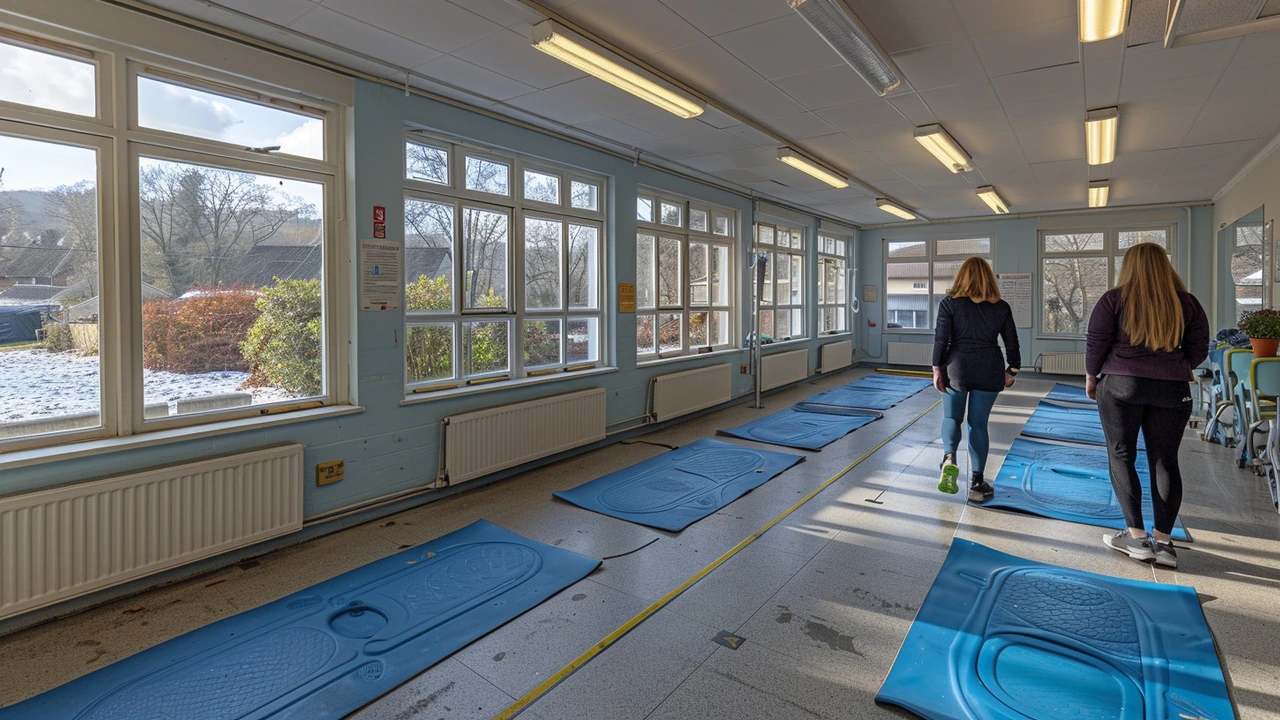Skeletal muscle conditions can dramatically affect a person's ability to perform everyday tasks. This is where occupational therapy steps in, offering a customized approach to help individuals regain independence and improve their quality of life.
Occupational therapists use their expertise to assess the challenges faced by their patients and develop targeted strategies to address those issues. By combining various techniques and interventions, they help patients manage symptoms, build strength, and enhance their functional abilities.
In this article, we will explore the different aspects of skeletal muscle conditions and how occupational therapy can make a significant difference. You'll find valuable information and practical tips to navigate the complexities of these conditions, whether you are a patient or a caregiver.
- Understanding Skeletal Muscle Conditions
- The Role of Occupational Therapy
- Techniques Used in Therapy
- Tips for Patients and Caregivers
Understanding Skeletal Muscle Conditions
Skeletal muscle conditions are a range of disorders affecting the muscles attached to bones, which are responsible for voluntary movements. These conditions can result from various factors including genetic disorders, injuries, and other diseases. They often lead to weaknesses, pain, and reduced function, which can make everyday tasks challenging or even impossible for those affected.
A common example is muscular dystrophy, a group of genetic diseases characterized by progressive muscle weakness and loss of muscle mass. Another prevalent condition is myopathy, which involves muscle fiber dysfunction. Both of these, along with many other muscle conditions, require careful management to maintain quality of life. Early diagnosis and intervention are critical in preventing or minimizing long-term damage.
Understanding the root causes of skeletal muscle conditions is crucial. Genetic mutations, autoimmune responses, inflammatory conditions, and metabolic disorders can all contribute to muscular problems. For instance, in autoimmune myopathies, the body's immune system mistakenly attacks its own muscle tissues, leading to inflammation and weakness.
These conditions are not just about physical decline; they can have profound emotional and psychological impacts as well. Chronic pain and disability can lead to depression and anxiety, making comprehensive care all the more essential. One essential aspect of that care is occupational therapy—a field dedicated to helping people regain their independence and improve their day-to-day lives.
Interestingly, some skeletal muscle conditions can be linked to lifestyle factors. Obesity, a sedentary lifestyle, and poor nutrition can exacerbate or even trigger musculoskeletal problems. Therefore, incorporating holistic approaches that include diet, exercise, and therapy can provide significant benefits.
“We must understand that skeletal muscle conditions impact not just the physical body but the soul too,” says Dr. Eli Friedman, a leading expert in muscle diseases.
Studies have shown that early intervention and a multidisciplinary approach can dramatically improve outcomes for those dealing with these conditions. By integrating medical treatments, physical therapy, and occupational therapy, patients can achieve a better quality of life. Experts believe that individualized care plans are the key to managing such complex conditions effectively.

The Role of Occupational Therapy
Such a preparation can be revolutionary for those dealing with skeletal muscle conditions. Occupational therapy is tailored to help individuals achieve autonomy in their daily lives. It helps in making everyday tasks easier—which can be incredibly challenging when dealing with limited muscle function.
The central aspect of occupational therapy is the personalized assessment of each patient’s unique needs and challenges. Therapists work closely with clients to understand their specific difficulties. The process involves more than addressing physical limitations; it includes cognitive, emotional, and social aspects impacting the person's life.
One of the remarkable benefits of occupational therapy is the holistic approach it takes. The therapy can involve everything from simple exercises to improve muscle strength and flexibility to teaching new ways of performing daily tasks. These tailored techniques can help people adapt their homes and workspaces to their specific needs, vastly improving their quality of life.
According to the American Occupational Therapy Association, “Occupational therapy practitioners ask, ‘What matters to you?’ not, ‘What’s the matter with you?’” This focus on patient priorities means therapies are not just about managing symptoms but about enhancing life quality and achieving what’s meaningful for the individual.
The holistic nature of occupational therapy means it meets patients where they are, addressing both the physical and emotional challenges they face.
Many occupational therapists use assistive devices as part of their practice. These can range from adaptive utensils for eating to advanced mobility aids for walking. The goal is to enhance independence and reduce the strain of daily activities. Occupational therapists also focus on energy conservation techniques, making it easier for patients to manage fatigue and balance their activities throughout the day.
Another essential aspect is education. Therapists educate patients and their families about the condition, helping them understand the challenges and strategies to address them. This education includes everything from proper body mechanics to avoid injury to guidance on nutrition and lifestyle adjustments to support overall health and well-being.
Psychosocial Support
In addition to physical therapy, occupational therapy also emphasizes mental health. The emotional toll of living with a severe muscle condition can be heavy. Therapists provide much-needed psychosocial support, helping patients cope with the stress and depression that often accompany chronic ailments. By incorporating cognitive-behavioral strategies and stress management techniques, they help patients build resilience and maintain a more positive outlook.
Through individualized interventions, occupational therapy enables patients to navigate the complexities of their conditions, empowering them to reclaim their independence and improve their quality of life.

Techniques Used in Therapy
When it comes to managing skeletal muscle conditions, occupational therapists use a variety of techniques to help patients gain strength and independence. These techniques are tailored to suit the individual's specific needs, ensuring that the therapy is both effective and engaging.
One noteworthy technique is therapeutic exercises. These exercises are designed to improve range of motion, strength, and overall function. Occupational therapists often create customized exercise plans that patients can follow both during sessions and at home. These exercises might include stretches, resistance training, and balance activities. By consistently following these routines, patients can see significant improvements in their muscle condition.
Another key technique is the use of adaptive devices. These tools can make daily tasks easier and more manageable for individuals with skeletal muscle conditions. Examples include ergonomic utensils for eating, specialized grips for writing, and custom-designed splints. Occupational therapists assess the unique challenges faced by their patients and recommend the most suitable adaptive devices to improve their quality of life.
"Occupational therapists play a crucial role in helping patients with skeletal muscle conditions regain their independence. Their expertise in creating personalized therapy plans is invaluable," says Dr. Jane Thompson, an expert in rehabilitation medicine.
In addition to exercises and adaptive devices, activity modification is a technique often used. This involves altering how a person performs a task to reduce strain on their muscles. For example, an occupational therapist might teach a patient new ways to lift objects, emphasizing proper body mechanics to prevent injury. They might also suggest breaking tasks into smaller, more manageable steps and incorporating rest breaks to prevent fatigue.
Therapists also utilize modalities such as heat, cold, and electrical stimulation to enhance muscle function. Heat therapy can increase blood flow and flexibility, while cold therapy can reduce inflammation and pain. Electrical stimulation can help activate muscles and improve their strength. These modalities are often used in combination with other techniques to provide a comprehensive approach to therapy.
Patient education is another cornerstone of occupational therapy for skeletal muscle conditions. Therapists take the time to educate patients about their condition, the importance of therapy, and how they can take an active role in their rehabilitation. This knowledge empowers patients, giving them the confidence to manage their condition more effectively.
Group therapy sessions can also be beneficial. These sessions provide a supportive environment where patients can practice exercises and techniques while receiving encouragement from their peers. Group settings can foster a sense of community and motivate patients to stay committed to their therapy plan.
Finally, occupational therapists collaborate closely with other healthcare professionals to ensure a holistic approach to treatment. This team-based approach ensures that all aspects of a patient's health are addressed, leading to better outcomes.

Tips for Patients and Caregivers
Managing skeletal muscle conditions involves a multifaceted approach that includes active participation from both patients and caregivers. To optimize the outcome of occupational therapy, embracing a few practical tips can make a significant difference in the therapeutic journey.
Firstly, it’s essential to maintain open communication with the occupational therapist. Regular updates on how the patient is coping with activities can help tailor the therapy to better meet individual needs. Don't hesitate to voice concerns or ask questions about the techniques being used. Sharing feedback allows therapists to make necessary adjustments to the therapy plan.
Creating a safe and supportive home environment is crucial. Ensure that the living space is free of clutter to prevent falls and make frequent-used items easily accessible. Installing grab bars in bathrooms and using non-slip mats are simple modifications that enhance safety and independence.
Consistency in following the prescribed exercises and daily routines is key. Practicing the activities demonstrated by the therapist not only helps in muscle strengthening but also in improving functional mobility. Setting a daily schedule can assist both patients and caregivers in staying on track.
Adopting a holistic approach by incorporating nutritional considerations can bolster muscle health. Maintaining a diet rich in proteins, vitamins, and minerals supports muscle repair and growth. Consulting with a nutritionist can provide personalized dietary advice that complements the therapy.
Emotional well-being is another important factor. Mental health significantly influences physical recovery, so fostering a positive attitude and reducing stress levels are important. Engage in mindfulness practices, gentle yoga, or other relaxing activities which can ease mental strain and support physical recovery.
Seeking support from support groups or communities can provide immense encouragement. Sharing experiences with others facing similar challenges can be uplifting. Caregivers, too, benefit from these groups since they offer a platform to share advice, vent frustrations, and gain new insights.
“Occupational therapy is most effective when patients feel empowered in their recovery process. It’s not just about physical exercises but also about building confidence and resilience,” says Dr. Emily Harris, an experienced occupational therapist.
Regularly attending follow-up appointments with the therapist can help in closely monitoring progress and making necessary adjustments. These check-ups are essential to ensure that the therapeutic interventions are yielding the desired outcomes and to address any other issues that might arise.
Finally, integrating assistive devices and technology can further aid independence. From simple aids like raised toilet seats to advanced mobility aids like electric wheelchairs, using the right tools can significantly improve daily functioning. The occupational therapist can recommend suitable devices that match the patient’s specific requirements.
By following these tips, patients and caregivers can maximize the benefits of occupational therapy, contributing to a more effective and enriching rehabilitation experience.


Colter Hettich
June 23, 2024 AT 05:02It’s fascinating-nay, profoundly existential-to observe how occupational therapy, in its quiet, unassuming manner, reifies the phenomenological rupture between embodiment and agency; the body, once a vessel of autonomy, becomes a labyrinth of diminished potential, and yet-through the meticulous, almost sacramental interventions of the OT-there emerges a reconstitution of selfhood, not through cure, but through adaptation. We must not mistake this for mere rehabilitation; it is, in truth, an ontological renegotiation: the patient, stripped of their former physical syntax, learns to speak a new language of motion, of presence, of dignity. The therapist, then, is not a technician, but a hermeneutician of the flesh.
Prem Mukundan
June 23, 2024 AT 09:47Look, I’ve seen too many people treat OT like a magic pill-stretching, gadgets, ‘energy conservation’-but real progress? It’s about discipline. You don’t get stronger by ‘modifying activities’-you get stronger by doing the hard reps, even when it hurts. No one’s gonna hand you independence. You earn it. Stop looking for shortcuts. If your muscles are weak, you train. Period. No jargon, no fluff. Just sweat.
Leilani Johnston
June 25, 2024 AT 03:38Y’all are overthinking this. OT isn’t rocket science-it’s just showing people how to do stuff without breaking. I had my grandma do OT after her stroke, and the biggest win? She could hold her coffee cup again. No fancy words needed. Just patience, a few adaptive spoons, and someone who actually listened. Also, pls stop calling it ‘ontological renegotiation’-it’s just a spoon, Colter. 😅
Jensen Leong
June 26, 2024 AT 08:28While I appreciate the philosophical depth of the initial commentary, I must emphasize the empirical rigor underpinning occupational therapy’s efficacy. Peer-reviewed studies demonstrate statistically significant improvements in ADL performance (p < 0.01) when multidisciplinary protocols are implemented. The integration of cognitive-behavioral frameworks with biomechanical interventions yields not merely functional gains, but psychological resilience. This is not anecdotal-it is evidence-based. We must honor the science behind the compassion.
Kelly McDonald
June 26, 2024 AT 11:59OMG YES. I work with kids with muscular dystrophy and let me tell you-the moment a 7-year-old uses a grip aid to draw their first full picture? That’s not therapy. That’s magic. 🌈✨ OT doesn’t fix muscles-it fixes hope. And sometimes? Hope is the only muscle that really matters. Also, if your therapist doesn’t laugh with you while you’re struggling to button a shirt? Find a new one. We’re humans first, healers second.
Joe Gates
June 27, 2024 AT 04:54I’ve watched my brother go from barely lifting a fork to cooking Thanksgiving dinner again-thanks to OT-and I can’t help but think how society underestimates this field. We throw billions at flashy surgeries and pharmaceuticals, but the quiet, daily work of helping someone tie their shoes? That’s the real miracle. It’s not glamorous, it doesn’t make headlines, but it’s the foundation of dignity. And dignity? That’s priceless. I wish more people understood that the smallest victories-like brushing teeth independently-are the ones that rebuild lives. We need more of this, not less. And we need to fund it like it matters-because it does.
Alex Hughes
June 27, 2024 AT 13:52OT works because it asks what matters to you-not what’s wrong with you. That shift in focus is everything. The medical model tries to fix broken parts. OT tries to rebuild meaning. It’s not about restoring function to pre-injury levels-it’s about creating a new version of normal. And normal doesn’t have to look like what it used to. It just has to feel like yours.
Hubert vélo
June 28, 2024 AT 15:48They don’t want you to know this-but OT is just the gateway drug. The real agenda? They’re training you to accept dependency so the state can control your mobility aids, your meds, your home modifications-all tracked through IoT devices. Next thing you know, your ‘adaptive spoon’ has a GPS chip and your therapist is reporting your ‘non-compliance’ to some algorithm. Wake up. This isn’t therapy. It’s soft control.
Kalidas Saha
June 30, 2024 AT 14:12MY BEST FRIEND DID OT AND NOW SHE CAN WALK AGAIN 😭😭😭 I CRIED WHEN SHE TOOK HER FIRST STEP WITHOUT THE WHEELCHAIR!!! I LOVE OT SO MUCH I STARTED A PETITION TO MAKE IT FREE FOR EVERYONE!!! 🙏💖 #OTIsLife #MuscleWarrior
Marcus Strömberg
June 30, 2024 AT 15:19Look, I’ve read the literature. I’ve met the experts. And I’ve seen the data. But let’s be honest-this whole field is just a glorified babysitting service for people who refuse to take personal responsibility. If you’re too weak to lift a fork, maybe you should’ve eaten better and lifted weights earlier. This isn’t a societal obligation-it’s a personal failure. And now we’re funding it with taxpayer money? Please. Real strength isn’t found in adaptive utensils. It’s found in discipline. And discipline? It’s not trendy. It’s not ‘inclusive.’ But it’s real.
Matt R.
July 1, 2024 AT 05:18Why are we letting foreign governments dictate our rehabilitation standards? The U.S. has the most advanced medical tech on earth-but we’re importing OT protocols from countries where they can’t even afford basic wheelchairs? This isn’t compassion-it’s cultural surrender. We need American-made, American-designed, American-tested therapy methods. Not some ‘holistic’ nonsense from a yoga retreat in Bali. Strength comes from steel, not ‘energy conservation.’ Build the muscle. Don’t just rearrange the spoon.